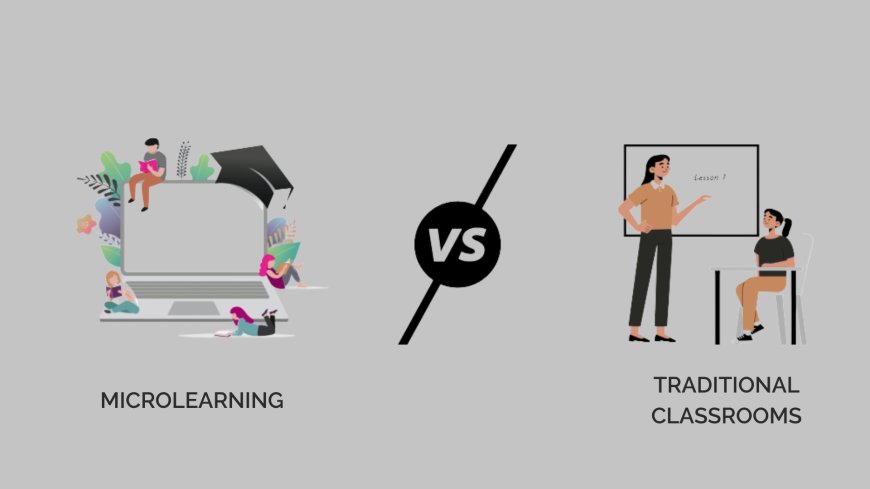Microlearning vs Traditional Classrooms: What Works in 2025?
The landscape of education is constantly evolving, with new methods of learning emerging alongside traditional practices.

As we move into 2025, the debate between microlearning and traditional classrooms continues to shape how we approach education. Both have their benefits and drawbacks, but the question remains: which one works best in today’s fast-paced, technology-driven world?
In this blog, we’ll explore both methods, compare their advantages, and help you understand what works in 2025 education.
What is Microlearning?
Microlearning refers to short, focused segments of learning, typically lasting anywhere from 2 to 10 minutes. It is designed to be quick, engaging, and easily digestible. This method focuses on delivering just-in-time knowledge in small, bite-sized chunks that can be consumed anywhere and at any time.
Key Features of Microlearning:
-
Short, Focused Sessions: Learners consume content in small, bite-sized portions, ideal for busy schedules.
-
On-Demand: Content is typically available digitally, meaning students can access it when needed.
-
Interactive: Often includes videos, quizzes, and games to increase engagement.
-
Targeted Learning: Focuses on specific skills or knowledge areas rather than broad concepts.
What is Traditional Classroom Learning?
Traditional classroom learning is the conventional model that most people are familiar with. It involves face-to-face interaction between instructors and students, with lessons being delivered over extended periods of time. While it is rooted in well-established educational methods, it is increasingly being challenged by modern alternatives like microlearning.
Key Features of Traditional Classrooms:
-
Structured Lessons: A set curriculum with specific learning goals.
-
In-Person Interaction: Direct communication between students and teachers.
-
Longer Sessions: Classes are typically longer, lasting anywhere from 45 minutes to several hours.
-
Group Learning: Emphasizes collaboration and discussion among peers.
Microlearning vs Traditional Classrooms: A Comparison for 2025
1. Learning Speed and Flexibility
-
Microlearning: Offers a highly flexible approach, where learners can access lessons anytime and anywhere. This is ideal for busy professionals or students with varying schedules. With bite-sized lessons, learners can progress at their own pace, and content is often tailored to specific needs.
-
Traditional Classrooms: In a traditional classroom, learning is typically paced by the instructor, and the structure of the course is rigid. Students have to attend classes at set times, which may not be suitable for everyone.
Winner: Microlearning – Greater flexibility and faster pace for those with limited time.
2. Engagement and Retention
-
Microlearning: Studies suggest that shorter learning sessions are more engaging and lead to better retention of information. With interactive content like quizzes, videos, and games, students remain engaged and more likely to retain knowledge.
-
Traditional Classrooms: While interactive elements like discussions, group work, and hands-on activities can engage students, the longer duration of lessons may cause fatigue and lead to lower retention. Additionally, students may find it harder to focus for extended periods.
Winner: Microlearning – More engaging with better retention rates due to short, interactive sessions.
3. Personalization of Learning
-
Microlearning: One of the greatest advantages of microlearning is the ability to personalize content. Learners can access specific topics or skills that they need help with, and self-paced learning allows them to spend more time on areas where they need improvement.
-
Traditional Classrooms: Personalization in traditional classrooms is more challenging because the pace is set for the whole class. Teachers may struggle to cater to the individual learning speeds and styles of all students, especially in large classes.
Winner: Microlearning – Offers better personalization and flexibility for individual needs.
4. Accessibility and Convenience
-
Microlearning: Highly accessible, as content can be delivered through mobile apps, websites, or learning management systems. This enables learners to access lessons on the go, making it ideal for remote workers, travelers, or anyone with a busy lifestyle.
-
Traditional Classrooms: Requires physical attendance in a classroom, which can be limiting for students in remote areas or those with busy schedules. The learning process is restricted by geographical location and specific class times.
Winner: Microlearning – More convenient and accessible, particularly in today’s digital age.
5. Cost-Effectiveness
-
Microlearning: Since microlearning typically involves online modules or smaller courses, it can be more affordable for both providers and students. The use of digital content also reduces costs associated with printed materials and in-person attendance.
-
Traditional Classrooms: Traditional classroom learning tends to be more expensive due to costs related to instructors, physical infrastructure, and class materials. For universities or higher education institutions, traditional classrooms may involve significant overhead costs.
Winner: Microlearning – Generally more cost-effective due to lower operational costs.
6. Suitability for Different Learners
-
Microlearning: Perfect for busy professionals or people looking to upskill quickly in specific areas. It’s also great for learners who have shorter attention spans or prefer to learn in short bursts.
-
Traditional Classrooms: Traditional classroom learning is still well-suited for in-depth education, especially when it comes to complex subjects or courses requiring hands-on learning. It's ideal for foundational learning and students who prefer face-to-face interaction.
Winner: Both – It depends on the learner’s needs. Microlearning is ideal for quick skills, while traditional classrooms excel for in-depth learning.
What Works Best in 2025?
In 2025, both microlearning and traditional classrooms have their place in the educational ecosystem.
-
Microlearning shines in today’s fast-paced world, where flexibility, convenience, and engagement are crucial. It works particularly well for professionals, lifelong learners, and people looking to upskill or learn specific topics in a short time.
-
Traditional classrooms, however, continue to be essential for comprehensive learning, particularly in fields that require deep understanding, hands-on practice, and peer interaction.
The Future of Learning
Looking ahead, we’re likely to see more hybrid models that combine the strengths of both approaches. For example, some universities and organizations are now using microlearning modules within traditional classroom settings to give students the flexibility to study on their own time while still benefiting from in-person instruction.
As we move forward into 2025 and beyond, it’s clear that personalized, flexible learning will dominate. While traditional classrooms will continue to play a vital role, microlearning is increasingly being recognized for its effectiveness, especially in catering to modern learners' needs.
Conclusion
Both microlearning and traditional classrooms have their advantages, but the right approach depends on the learner’s goals and context. For quick, on-the-go learning, microlearning provides an efficient solution, while traditional classrooms continue to serve those seeking deeper, more structured learning experiences. As the world of education continues to evolve in 2025, expect a shift toward more flexible, accessible learning methods that offer the best of both worlds.

 Ayesha Mir
Ayesha Mir